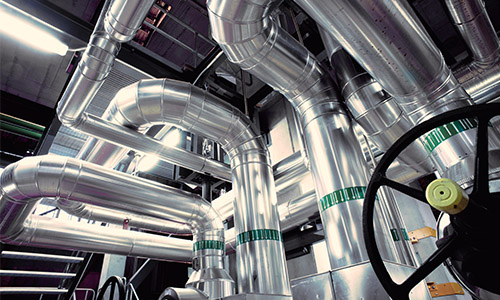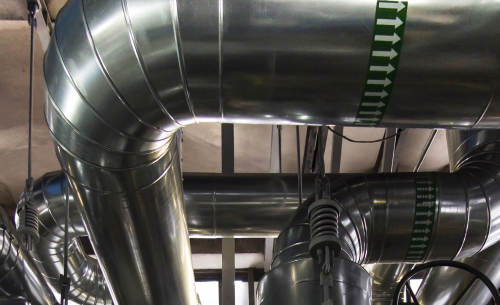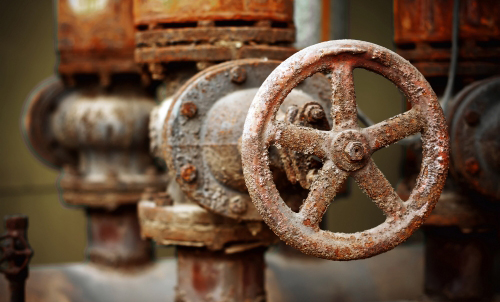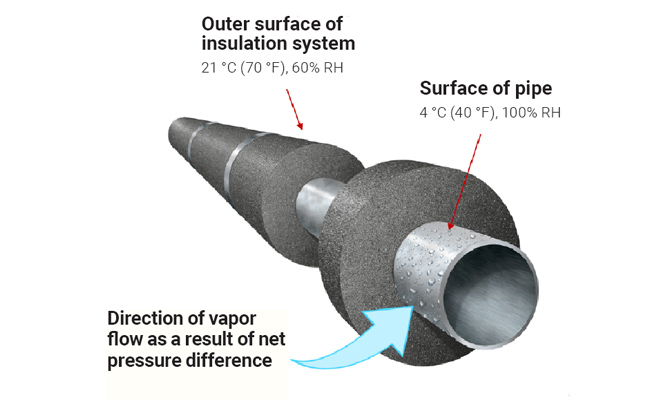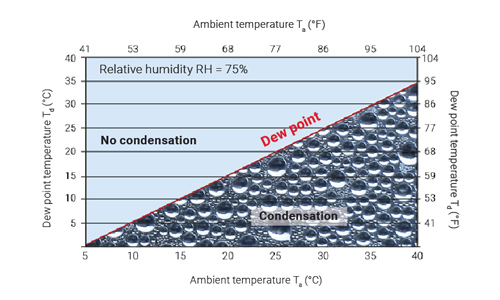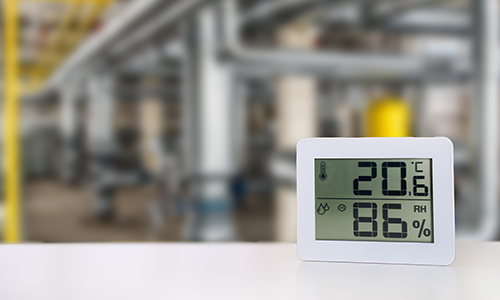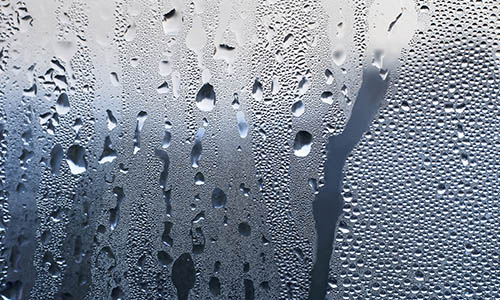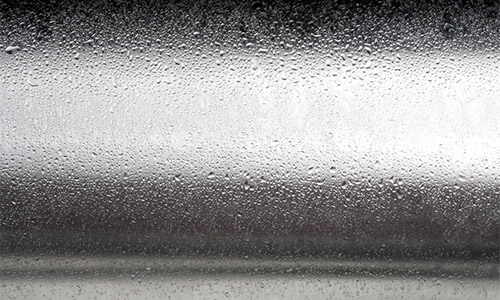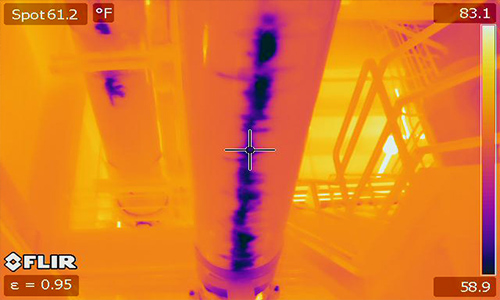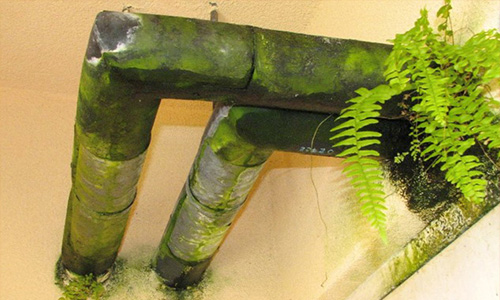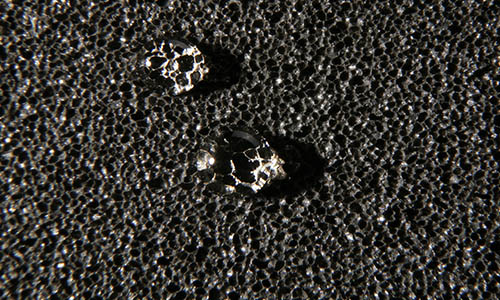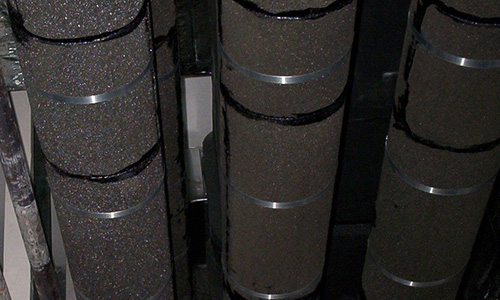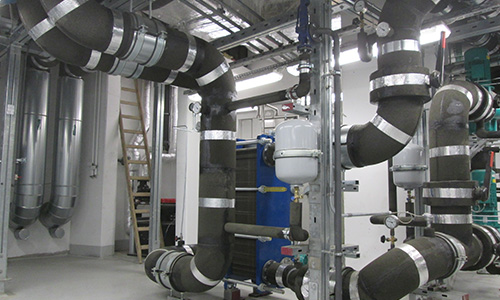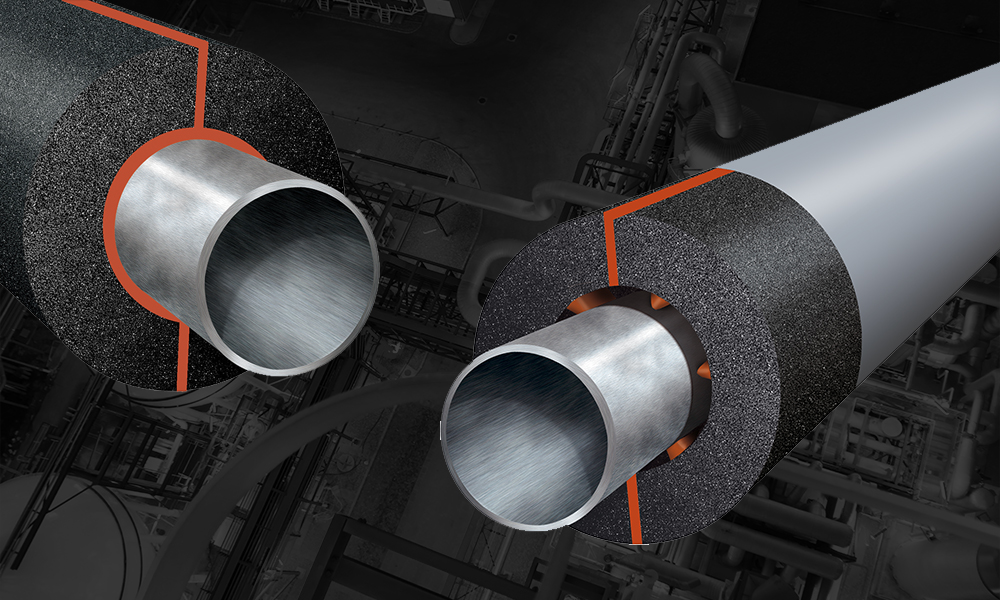The impact of moisture in chilled water insulation systems

Chilled water and other below ambient systems are present in large commercial buildings and a wide range of manufacturing facilities. These applications require an insulation system that resists vapor drive to help ensure the process performs as designed.
It has been estimated that 98% of the problems with insulation systems are due to moisture.* Moisture penetration of insulation on lower-temperature systems is a serious issue, especially in areas with both high ambient temperatures and relative humidity.
The resulting high vapor pressure can force moisture into a permeable insulation material. While such conditions are normal in hot, humid regions, these can occur virtually anywhere during severe weather.
Whenever the dew point temperature is above the operating temperature of a system, the potential for moisture penetration is present.
Common problems with chilled water insulation systems.
The specification of thermal insulation for a 4.4 °C (40 °F) chilled water distribution network is often considered routine by many engineers.
Yet, many have encountered failed chilled water insulation systems, and numerous chilled water insulation systems that are currently being installed will likely need to be replaced after less than a decade in service due to poor selection of insulation material.
Some of the most occurring problems:
- Increased operating costs due to lost efficiency
- Moisture penetration; breaching at joints and fittings
- Corrosion of pipes, valves and fittings
- Formation of mold and mildew and associated health problems
- Dripping pipes that can damage ceilings, walls, floors and equipment
- Inability to maintain “zero defects”
These problems expose the potential difficulties with seemingly benign chilled water insulation systems and suggest that greater attention must be paid to moisture penetration in chilled water and other similar lower-temperature systems.
Humidity, vapor pressure and dew point.
Moist air is a mixture of dry air – atmospheric air without water vapor or contaminants – and water vapor. Absolute humidity is a measure (lb/ft3x10-4; kg/m3x10-4) of the moisture content of moist air at a given temperature. This can vary from zero, for dry air, to saturation, with saturated air at higher temperatures capable of holding more water vapor than at lower temperatures. Alternatively, relative humidity, measured as a percentage, compares the actual amount of moisture in air versus the amount that it could hold at that temperature.
The higher the air temperature, the greater its vapor pressure (in-Hg; cm-Hg) – the pressure at which water, liquid and vapor exist in equilibrium. So, when the air temperature is lowered, this equilibrium is disturbed, and liquid water condenses as “dew” until equilibrium – the vapor pressure for the lower temperature – is established.
The temperature at which this condensation begins is called the dew point. As we will see, the existence of vapor pressure differences, particularly under humid conditions, is the nemesis for permeable insulation on chilled water systems.
For the typical lower-temperature system, the vapor pressure is higher at the outer surface of its insulation cover than at the insulation/pipe interface, typically creating an unstable condition. In order to attain equilibrium, there is a flow of water vapor inward, toward the surface of the cold pipe.
This is the vapor pressure drive and it exists in every climate. As the difference between inner and outer surfaces conditions increases, so too will the pressure drive.
This inward passage of water driven by vapor pressure differences develops any time the cold/low-temperature or chilled water system (normally at 4.4°C to 7.2°C (40°F to 45°F) operates below the local dew point, which for humid coastal areas is a regular condition.
As the dew point temperature increases, the vapor pressure of saturated air increases; and, as the operating temperature and the dew point increase, the vapor pressure drive into the system insulation also increases.
In severe circumstances, insulation can be destroyed in one cooling season. Only under extremely dry ambient conditions does the vapor pressure drive reverse.
Condensation prevention
Because of these dynamics in the usual chilled water and similar temperature system environments, the goal of system design should be to maintain the outer surface temperature of the insulation above the dew point for the likely range in ambient air conditions.
The water vapor permeability of the insulation material is a critical component of reaching this goal. With permeable insulation materials, moisture can move through the insulation to reach areas where the temperature is low enough to form condensation, even if the surface temperature of the insulation is high enough to prevent surface condensation. An impermeable insulation material help prevent this from happening.
A large design consideration is that systems need to be designed for extreme conditions and not just averages. If the engineer does not take the extreme humidity conditions of the space into account or the system functions outside the normal design parameters, the insulation thickness may not be enough to make up for the increase in water vapor in the air and condensation will form as the surface temperature falls below the dew point.
A common source of moisture problems in chilled water systems occurs at startup of a new system. Systems are often started while the building is still open exposing it to conditions outside of the design parameters with condensation and possible moisture intrusion as a result. If the insulation selected is a closed cell material, this issue is minimized, since the insulation is inherently resistant to possible moisture absorption, even without a jacket.
The impact of moisture penetration
A design consideration to condensation prevention, and possible only with impermeable insulation, is to prevent moisture intrusion as a result of varying vapor pressure differences. This approach can be ultimately more critical to the life of chilled water insulation. While moisture vapor intrusion can progress for some time before becoming visible, surface condensation and the dripping that results are usually easily recognizable.
Several studies* have researched the negative impact of moisture on the thermal conductivity of various insulation materials and found a wide range of thermal conductivity intensification for a given moisture content. Their studies suggest that it is unlikely that any single universal relation exists for different insulation materials; however, the data clearly indicates large negative effects on thermal conductivity at elevated moisture content. Recent studies on open cell insulation materials have shown that a 1% increase in moisture content can result in a 23% increase in thermal conductivity.*
* A M Gusyachkin et al 2019 IOP Conf. Ser.: Mater. Sci. Eng. 570 012029
Furthermore, the impact of moisture intrusion does not end with the degradation of insulation and chilled water system efficiency. Moisture intrusion is the common denominator in other effects including surface sweating, mold and mildew formation, as well as a likely increase in the corrosion of pipes, fittings, hangers, etc.
The transmission of water vapor into insulation on a chilled water or other similar-temperature pipeline, the degradation of thermal insulation performance, and the resultant rise in operating expense are often overlooked by owners and designers focusing only on initial system costs.
A more realistic approach should also include maintenance/repair and potential replacement due to system failure.
Long-Lasting Chilled Water Insulation Systems with FOAMGLAS® insulation
The most practical approach to long-term efficient chilled water insulation systems that also provide the most economical lifetime performance, is the use of inherently low permeability insulations.* One of the only service-proven materials with decades of in-the-field performance in this category is FOAMGLAS® cellular glass insulation. Its all-glass composition is highly resistant to moisture in vapor form, does not have to rely on additional vapor retarders and is impermeable – critical for optimum chilled water line performance.
The moisture-resistance of FOAMGLAS® insulation allows retention of its original insulating value for many years. In fact, there are many instances of installations in place well over 30 years with no sign of insulation deterioration or reduced thermal performance.
The high strength to weight ratio of FOAMGLAS® insulation makes it ideal for suspended chilled water lines and allows it to withstand physical abuse and loads.
Because of this strength, shields or “cradles” maybe used for suspended and vertical systems, allowing pipe insulation to remain continuous, thus more efficient, without thermal “shorts”.
The inert, impermeable material properties prolong both its own life and that of the chilled water lines as the risk of formation of corrosion is mitigated. The absence of any chemical components also protects piping from accelerated corrosion.
Chilled water systems are frequently installed in large buildings, stadiums or facilities, where fire safety is always a key requirement. Because FOAMGLAS® insulation is 100% glass, without binders or fillers, it will not burn, even when in direct contact with intense flame.
It can serve to protect piping and equipment from fire damage, and will not contribute to the spread of flames or formation of toxic fumes, helping to safeguard people inside the building or facility.
Proper specification and installation of an impermeable FOAMGLAS® insulation chilled water system is a solid investment in your building or facility that will help to reduce the lifetime energy costs, reduce operation and maintenance costs and avoid future risks for all parties involved. Choosing the correct insulation system will help to reduce the mechanical systems’ total cost of ownership and thereby their overall life-cycle costs.


